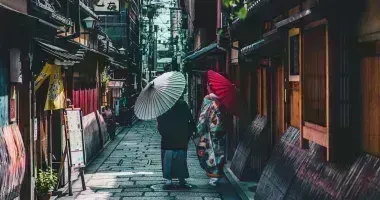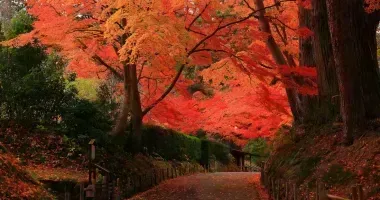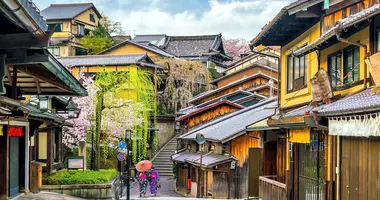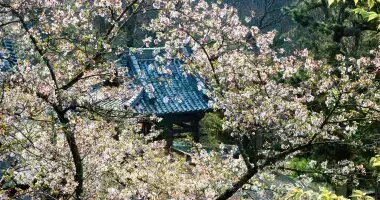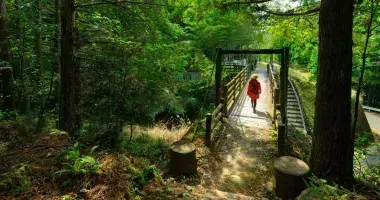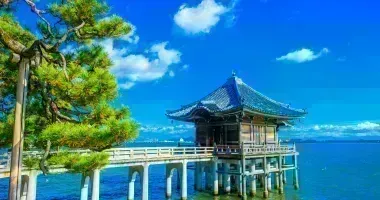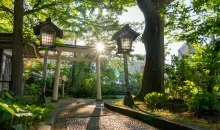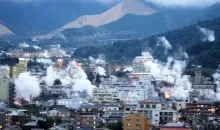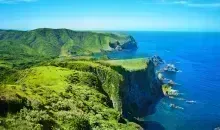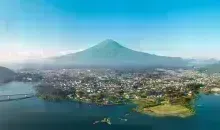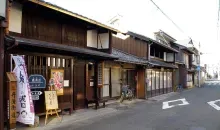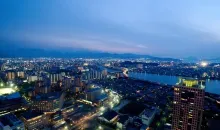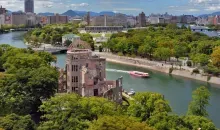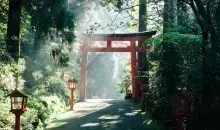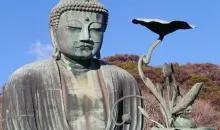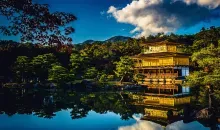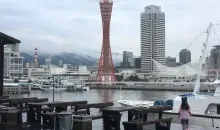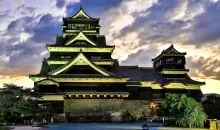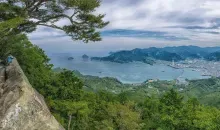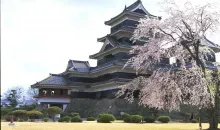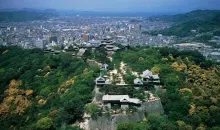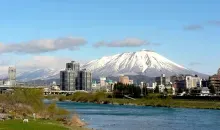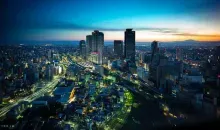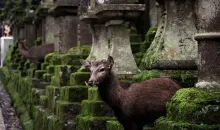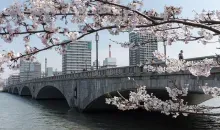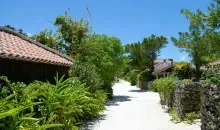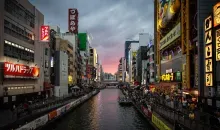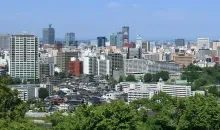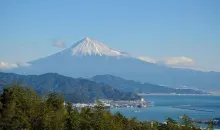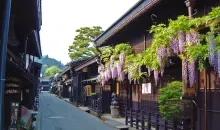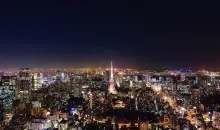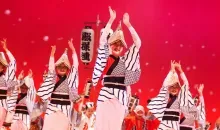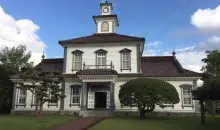Izumo 出雲
Hora local 09:20
Symbol : sunny_cloudy
Temp : 16.2°C
Date : Hoy
Symbol : cloudy
Temp : 15.7°C
Date : Mañana
Symbol : cloudy_rainy
Temp : 19.4°C
Date : Domingo
Symbol : cloudy_rainy
Temp : 13°C
Date : Lunes
Hora local 09:20
Symbol : sunny_cloudy
Temp : 16.2°C
Date : Hoy
Symbol : cloudy
Temp : 15.7°C
Date : Mañana
Symbol : cloudy_rainy
Temp : 19.4°C
Date : Domingo
Symbol : cloudy_rainy
Temp : 13°C
Date : Lunes
Situated just 34km west of Matsue, the provincial capital of Shimane Prefecture, Izumo is a pleasant and relaxing city, with a population of about 145,000 people, and much to see in and around it.
Nearest Airport
Izumo Airport (IZO) - 30 by bus to Izumo city
Train Stations
Izumoshi (JR Sanin Main Line)
Dentetsu Izumoshi Station (Kita-Matsue Line on the Ichibata Electric Railway)
Izumo Taisha-mae (Ichibata Electric Railway)
Izumo Travel Guide
Situated just 34km west of Matsue, the provincial capital of Shimane Prefecture, Izumo is a pleasant and relaxing city, with a population of about 145,000 people, and much to see in and around it.
Izumo's big attraction is the impressive Izumo Taisha shrine, second only in importance to the Grand Shrine in Ise. Izumo Taisha, also known as Izumo Oyashiro, is said to be the oldest Shinto shrine in Japan having existed on its present site for 1,500 years. Legend has it the shrine was built by the goddess Amaterasu and that the million Shinto gods return here every October.
The current shrine buildings date from 1744 and the main building (honden) is the largest shrine structure in Japan. One of the shrine's presiding gods is Okuninushi, the deity of marriage and visitors here often come to pray for luck in finding a partner.
Outside the main hall of worship are massive straw ropes - shimenawa. Good luck falls on those visitors who can toss a coin that lodges in the cut ends of the ropes.
Izumo Taisha is 8km outside Izumo city and can be reached by train to Izumo Taishamae on the Ichibata Line. A tourist office is just outside the main torii gate to the shrine on your left.
Izumo's Museums & Temples
The modern Shimane Museum of Ancient Izumo is a short walk from Izumo Taisha and definitely worth a visit. This excellent museum showcases some of the major finds in the Izumo area of recent years - a area key to the historical development of Japan due to its close cultural and trading ties with Korea. The several sections of the musem include exhibits on Izumo Taisha, Lafcadio Hearn, and the superb 358 bronze swords that were excavated at nearby Kojindani.
Also in the Izumo Taisha area is Old Taisha Station converted to a free museum in 1990. Opened in 1924 the wooden station building is modeled on Izumo Taisha Shrine. Taisha Station is unusual in that it is completely traditional and not incorporating any western architectural features like most other stations built at that time, and is now registered as an Important Cultural Property. Outside stands the obligatory steam locomotive, while inside are mannequins wearing period uniforms as well as ticket machines and other historical equipment as well as photos. The station is a very popular destination for Japanese railway buffs.
The Izumo Yayoi-no-mori Museum is situated in the hills to the south of central Izumo city, across the road from the Nishitani Tumuli Park to which it is adjacent. The Izumo Yayoi-no-mori Museum opened in 2010 to display artifacts that had been unearthed from the burial mounds in the tumuli park. As well as displays of historic pottery, jewelry and other grave goods there are models of the interior of the tomb and of how it is believed the tombs were constructed. The displays are good but there is no explanation in English.
Also south of the JR tracks are the Imaoka Art Museum to the west and Izumo Science Museum just south of the Izumo Kagakukan Park Town Station on the Ichibata Railway Kitamatsue Line.
The Izumo Museum of Quilt Art is located in a renovated traditional farmhouse surrounded by rice paddies east of Izumo city, and is both difficult to reach and not well advertised, but nevertheless attracts rave reviews from those who do manage to visit it. In fact the works on display come from just one artist, Mrs. Mutsuko Yawatagaki, a local woman whose quilts have been exhibited internationally.
The fabrics used in her creations come from antique and vintage kimonos, some as much as 200 years old. If you expect quilts to be bold, simple, geometric, and with a limited range of colors, you will be surprised, as they look more like paintings, with fine details and a wide range of subtle colors.
The Izumo Cultural Heritage Museum is a little off the beaten track but well worth a visit especially for those with an interest in gardens, particularly those associated with the tea ceremony. Situated within a large, walled, compound, you will notice that the western edge is planted with a line of tall, straight, pines trees planted close together. This is called a tsujimatsu and is a unique feature of the Izumo region. The tsujimatsu is in essence a windbreak and can be seen on many of the farmhouses across the nearby plain. After entering through the Nagayamon gate you come face to face with the Izumo Yashiki, the huge mansion that, like the gatehouse, belonged to the Ezumi family, who were one of the leading landowners in the Izumo region.
Hinomisaki Shrine, north west of Izumo on Cape Hinomisake has a superb location. The shrine was built by in its present form by Tokugawa Iemitsu in 1664. The shrine has been recently renovated and repainted. A short walk from here is the Meiji Period Hinomisaki Lighthouse, built in 1903 and supposedly the highest stone lighthouse in Asia at 44m. Just off the cape is Fumishima, a small islet and a breeding site for thousands of gulls. Buses take around 20 minutes out to the lighthouse.
Continuing east on the coast road would bring you Ichibata Yakushi Temple, dedicated to Yakushi Nyorai, the Buddha of medicine and healing, and a place of pilgrimage for those with any kind of eye complaint.
Izumo Dome
Izumo Dome is an indoor sports and event arena designed and built in 1992 by the Kajima Corporation. Its design is based upon the structure of Japanese umbrellas, and is a strikingly elegant building, although that is more apparent from the inside.
The skin of Izumo Dome is translucent so the inside is bathed in warm light and so no artificial lighting is needed for daytime events. If you visit when there are no events taking place the staff will allow you to walk out to the center of the dome and if you look up you might imagine you were under the dome of a great European cathedral or Islamic mosque.
Izumo Festivals
Two important festivals at Izumo Taisha are the Imperial Grand Festival from May 14-16 each year and the Kamiari-sai in late November which celebrates the annual coming of the Shinto gods.
There is a Tourist Information office located in Izumo JR station and one at Izumotaisha-mae Station.
Around Izumo
Tachikue Gorge, located on the Kando River about 8km south of Izumo, is a National Scenic Spot because of its dramatic cliffs and rock formations sculpted by erosion. There are two pedestrian suspension bridges across the Kando River and several kilometers of footpath to admire the impressive scenery.
The highlight of Tachikue Gorge are the 1,500 Buddhist statues, many with vermillion caps and bibs, that can be found clustered around the bases of huge cedar trees, along the foot of the cliff, in small caves in the cliff wall, and in almost every available nook and cranny.
Gakuenji Temple, located in the remote Kitayama mountains to the north east of Izumo is famous for its autumn colors and has a number of interesting buildings to explore. Gakuenji is temple number three on the Izumo 33 Kannon Pilgrimage, an old pilgrimage route from before the Edo Period.
Gakuenji is also temple number 25 on the Chugoku 33 Kannon Pilgrimage, a much newer but much longer pilgrimage route. Finally Gakuenji is a part of the Izumonokuni Shinbutsu Reijyo a new pilgrimage route that combines 20 sacred sites in Izumo, both Buddhist temples and Shinto shrines.
Even so, the chances are that you will encounter few, if any, other people on a visit outside of a sunny weekend, with the big exception being in late November when the grounds are crowded with thousands of visitors for the impressive display of autumn colors that fill the temple grounds and surrounding mountainsides.
Izumo has two noteworthy wineries: Shimane Winery close to Izumo Taisha and Okuizumo Vineyard south of the city. Both places offer local Izumo wine and excellent restaurants.
Located a short distance from Unshuhirata Station on the Ichibata Line near the western end of Lake Shinji, the Honjin Memorial Museum is often overlooked by visitors to the Izumo and Matsue area but has much to offer and well worth a detour from the main tourist destinations. Honjin were Edo era inns for high level government officials and feudal lords, who were known as daimyo. Often, as is the case here in Hirata, honjin were the homes of well-to-do village headmen or rich merchants, and in return for their home being designated as a honjin they were allowed to build walls, gates, and other markers of a status above their rank in the strict Tokugawa hierarchy.
Also in Hirata, close to Unshuhirata Station, are the preserved Edo and Meiji Period buildings that make up Momen Kaido (Cotton Road), an area that became a prosperous merchant center when locally produced Hirata cotton became much sought after, especially in the Kansai region of Osaka and Kyoto in the late Edo era.
Nearby Kokokuji Temple to the west of Hirata is home to a dry karesansui garden that utilizes the borrowed scenery of a small reservoir and the 456m high Mount Tabushi. Kokokuji Temple dates back to 1322 but the attached garden is much newer, being completed in 1833 and built by Sawa Gentan who worked for Matsudaira Fumai, the 7th Lord of Matsue.
Iwami Ginzan Silver Mine is a UNESCO World Heritage site in the mountains of Oda City, about 1 hour by car, or 2 and a half hours by train, south-west of Izumo. Iwami Ginzan was Japan's most productive silver mine for the four centuries it was operated, from the 1520s to the 1920s. It is a huge site, a visit to which can include access to actual mine shafts, Rakanji Temples with its caves, a 150-year-old silver merchant house, and the Iwami Ginzan Silver Mine Museum.
Access:
Train
JR Izumo-shi Station is a main station on the JR San-in Line, which connects Izumo to Matsue along the southern shore of Lake Shinji.
The slower Ichibata Railway Kitamatsue Line runs to the north of the lake between the two cities. Dentetsu Izumo-shi Station is to your right as you exit the main JR Izumo Station. The nearest Shinkansen is to the south in Okayama, from where local trains reach Izumo in about 3 hours.
The Izumo Sunrise is an overnight sleeper train that leaves Tokyo Station at 10 pm nightly for Izumo. It splits at Okayama at 6.27 am with the Sunrise Seto part of the train going to Takamatsu on Shikoku. The Izumo Sunrise arrives in Izumo at 9.58 am the next day.
Bus/Car
Izumo is located on Route 9. From Okayama follow the Okayama and Yonago Expressways, then Route 9. There are overnight Highway Buses from Fukuoka, Nagoya and Tokyo and daily buses to Osaka and Hiroshima. Hiroshima is a good place to rent a car to head north in to Shimane Prefecture.
Si te interesa Izumo
Descubre y explora otras ciudades



